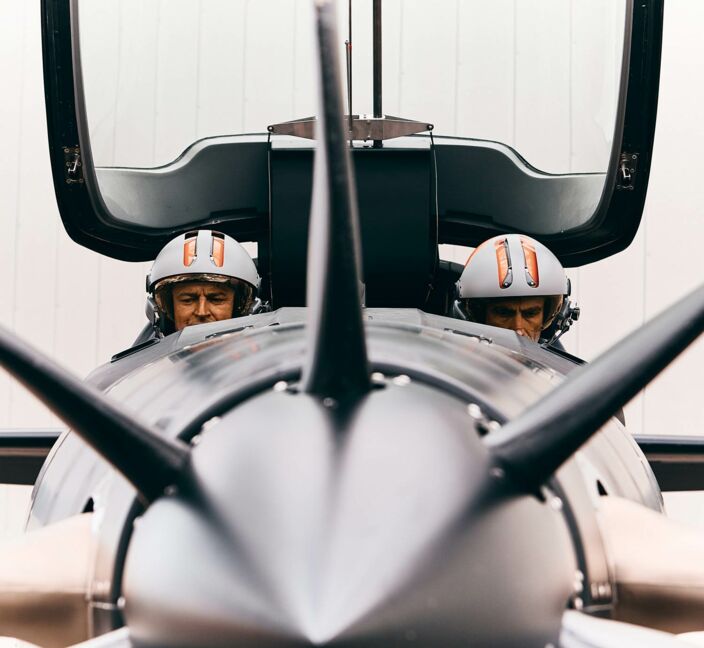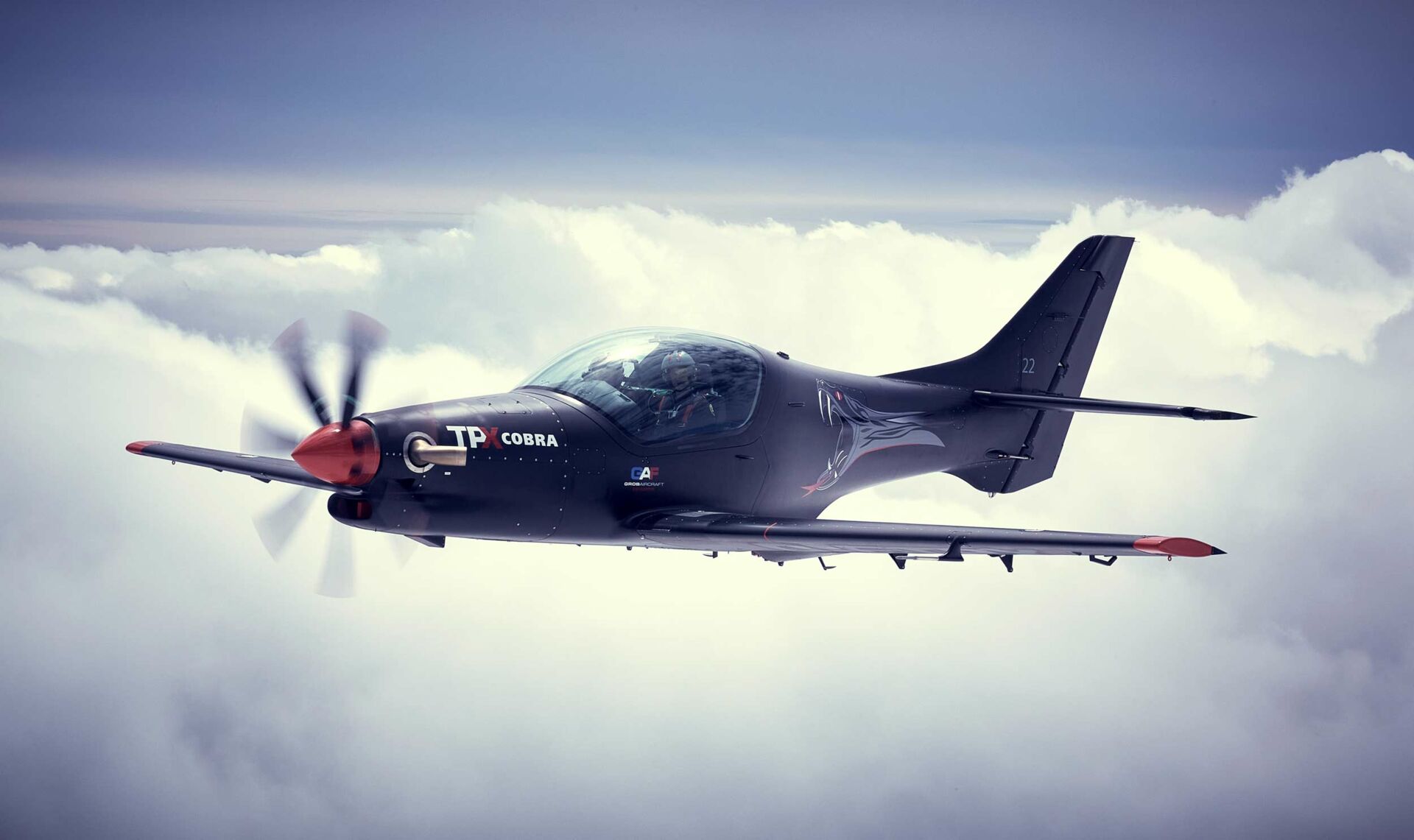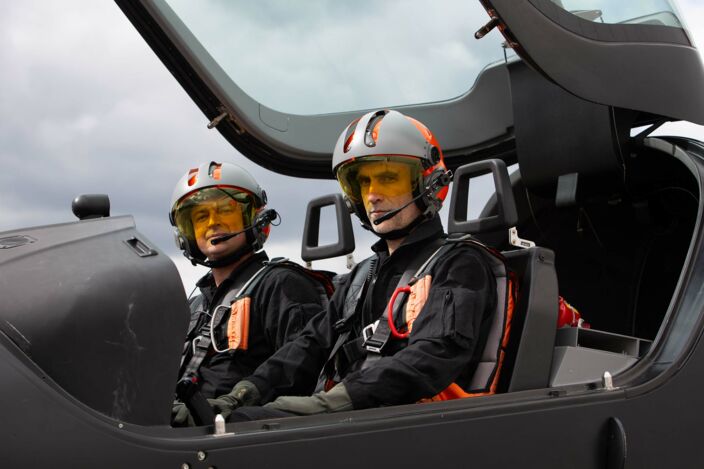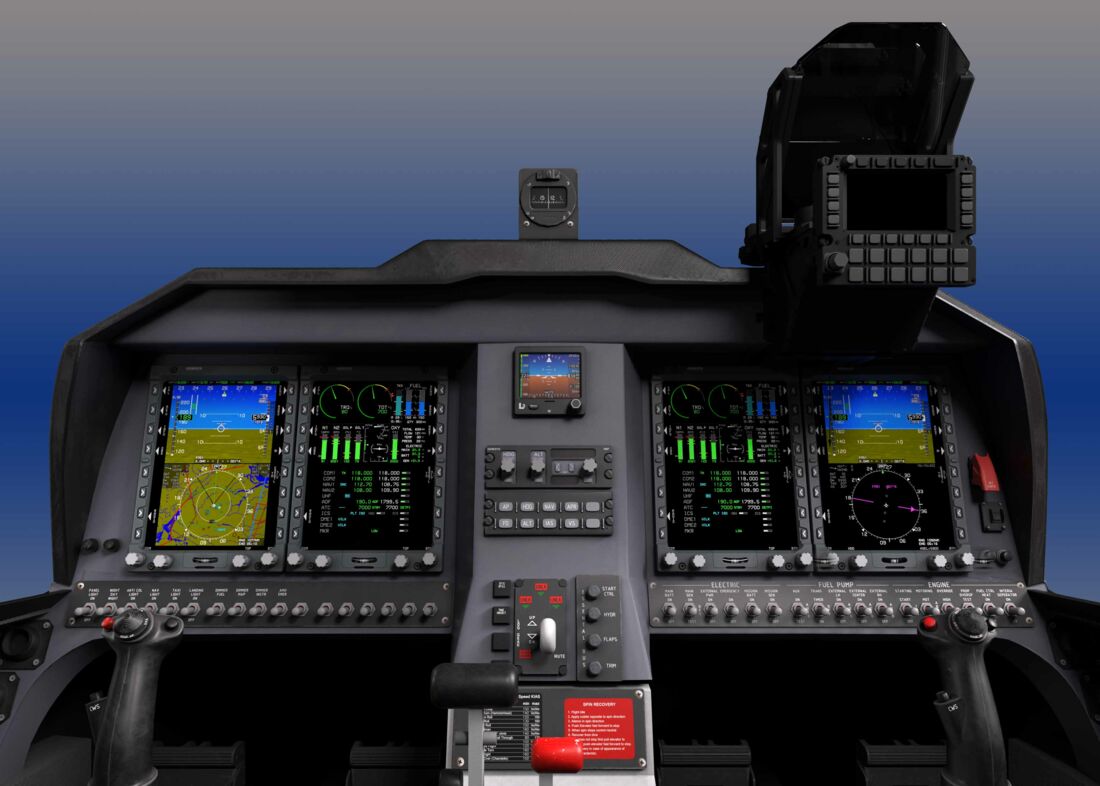THE FUTURE IS NOW
The TPX is a low-wing, side-by-side, two-seater monoplane powered by a Pratt & Whitney Canada PT6A-25C turboprop engine with 750 HP, 7-blade propeller by MT-Propeller, and equipped with two Martin-Baker ejection seats. Based on the initial concept by Grob Aircraft SE, the aircraft was further developed and will be fully manufactured in France.
Certified to EASA, CS23 Amendment 5, the TPX can be operated under VFR and IFR, day and night. Its performance and equipment enable it to operate in both military (CAM) and civil (CAG) air traffic.
The aircraft can be operated single-pilot or with a crew. In single-pilot mode, the pilot uses the right-hand seat. For an instructional flight, the student pilot sits on the right and the instructor on the left.
Side-by-side seating gives both crew members full access to all engine start/stop, flight control and fault management functions.
The instructor can also simulate malfunctions or inhibit functions by masking certain Glass Cockpit system functions, or by activating certain breakers linked to the aircraft's landing configuration (landing gear or flaps).

KEY FEATURES
- Elementary and Basic military pilot training to Advanced training for transport and fighter aircraft
- Propulsion system Engine: Pratt & Whitney Canada PT6A-25C turboprop engine
- Maximum take-off power (MTOP) = 750 SHP (5-minute limit)
- Cruise power (MCP) = 700 SHP
- Ejection Seats: Martin-Baker ejection seats, fitted with anti-g valve
- Propeller: MTV-37-1-E-C-F-R(P)/CFR210-56 (7 blades)
- G Loads: +7.0g, -4.g
- Normal and aerobatic category
- Certified to EASA, CS23 Amendment 5
- VFR and IFR, day and night, formation flight
- Single-pilot or with crew
- Side-by-side seating
- Made in France
ADVANTAGES OF THE SIDE-BY-SIDE COCKPIT LAYOUT
The cockpit is designed to accommodate two pilots, with the main pilot's seat on the right-hand side. All controls and indications required for flight are positioned in relation to the pilot's seated position.
Keeping in line with our proven teaching philosophy of side-by-side training, the TPX continues this tradition enabling demonstration, supervision, monitoring, and corrective actions by the instructor pilot.
- Enhanced Communication and Interaction: The instructor can observe the student's actions more closely and provide immediate feedback and correction.
- Improved Learning Environment: The instructor can easily point out instruments and controls, making explanations more straightforward.
- Better Observation and Demonstration: Both the instructor and student have a clear, shared view of the instrument panel, which aids in teaching and learning. The instructor can also more easily demonstrate proper techniques and hand movements by using the same controls the student is using.
- Safety and Control: In an emergency, the instructor has immediate access to all controls and can take over quickly if needed. Both individuals experience the same flight conditions and scenarios, allowing the instructor to better understand the student's perspective.
- Enhanced Training Dynamics: Training sessions are more interactive, with both the instructor and student engaging in discussions about the flight in real time.
MODULAR GLASS COCKPIT
The TPX instrument panel features an EFIS system with two screens on the PIC side and two screens on the co-pilot side, providing a fully integrated digital cockpit The main part of the avionics system is the Genesys Aerosystems' basic Electronic Flight Instrument System (EFIS) consisting of two IDU-680 integrated display units.
EFIS is a complete flight instrumentation and navigation system that intuitively provides information to the pilot via computer-generated displays. The displays are divided horizontally into two functional zones. The display area is 6" x 8" (10.4" diagonal) in portrait orientation. Resolution is 1024x768 pixels with anti-aliased graphics.
Both displays can perform the same functions, but each represents an independent/redundant unit. Each display can depict two different set of information, one on the top and one on the bottom. In case of failure of one display, the PFD and the EICAS are automatically projected onto the remaining display.
All displays communicate with each other (but do not depend on each other) and all sensors are connected in parallel, so that each display is independent, and with the exception of fixed zones, can display any page at any time.
Each integrated display unit (IDU-680) is equipped with a sunlight-readable AMLCD screen, and features the following main functionalities: primary flight instruments (PFI), flight management system (FMS) based on GPS SBAS data, audio system control, COM/NAV radio control and display, Terrain Awareness Warning System (TAWS), circuit breaker control, etc.
In normal mode, the primary flight instruments (PFI) are located at the top of the primary flight display (PFD, right-hand side). The lower half of the PFD is used for the moving navigation map. The engine instruments and crew alerting system (EICAS) are located at the top of the secondary screen (left side). The lower half of the secondary display is used for radio tuning, audio system control, the horizontal situation instrument (HSI) or flight plan information. This mode is considered the normal mode, in which pilots operate under normal conditions.
The PFI functional area is always fixed in the upper part of the main flight screen. The pilot can modify the lower part of the screens to display other MFD pages, including the moving map, navigation log, traffic display, engine/cell crew alert system (CAS), circuit breaker control and radio/audio controls.
The PFI will be able to transmit on either radio from a single action in the cockpit, using a COM1/COM2/COM3 switch on the control stick and a frequency control switch in the center console.




